Global energy supply has had a significant impact on business prosperity. BP is one of the companies that has had a significant impact on the industry. This document is intended to provide an overview of BP. It will discuss its history, strategies, and primary business areas. This essay delves into Bp Groeit, Benzine, Climate Goals, Brandstof, and problems. These include expansion, a transition away from popular but unhealthy fuels such as benzine, and initiatives to achieve exciting but difficult climate change goals.
Some Facts About BP
BP was a leader in the oil and gas business. However, it has recently attempted to plan for a more sustainable environment. Clearly, there is a global trend toward using fewer nonrenewable resources. As a result, BP is making significant efforts to transition from petroleum to renewable energy sources.
BP Growth (Increase): Bp Groeit, Benzine, Climate Goals, Brandstof,
In general, BP’s corporate growth strategy is to increase market share, which must be achieved while considering the environmental impact. The company has strong spending plans for research and development in order to produce better, greener energy. They also strive to make their processes more efficient. BP stands apart due to its focus on growth and sustainability. It identifies BP as a crucial participant in the energy transition.
Climate goals
One of the key issues facing BP is its inability to satisfy climate commitments. These targets are not simply targeted at reducing gas emissions, but rather at transforming the entire energy industry. BP has stated that it would become a net zero firm by 2050. This includes reducing carbon emissions significantly and increasing the usage of renewable energy.
Driving drivers and challenges in achieving climate goals
It’s an exceptionally difficult obstacle course for a company created in the oil and gas sector. BP faces increasing opposition, and numerous obstacles prevent the business from meeting its climate commitments. However, BP wants to expand its operations.
Balancing Growth and Sustainability.
Bp Groeit, Benzine, Climate Goals, Brandstof,-1
The global economy is rapidly shifting toward renewable energy. That is why BP must examine this in order to become a competitive green energy firm.
Technological and Economic Challenges
The transition to renewable energy is complex. They are in the technological and economic fields. The difficulties are not trivial. Clean energy technology has been a difficult undertaking for humanity due to the complexity and high expenses involved in developing such forms of energy.
The main areas for BP’s expansion
We must emphasize the value of Benzine to the company. Then we’ll dig deeper into the outcomes of its utilization. We’ll also see how well it performs in this region.
Benzine, sometimes known as gasoline, is an essential substance. It has molded BP’s manufacturing and global brand for several decades. However, as people become more concerned about the environment and use cleaner energy, the importance of benzine is waning.
Environmental impact; Bp Groeit, Benzine, Climate Goals, Brandstof,
Benzine is a powerful substance that impacts the air. It pollutes the atmosphere and contributes to greenhouse gas emissions. Benzine is a significant component in BP’s products. The corporation recognizes that it cannot continue to use it as is. BP is acutely aware of the need to develop new methods of producing energy that are less harmful to the environment than benzine.
Transition to alternatives
Benzine contamination has serious consequences for the environment. To address this important issue, BP is exploring and growing the manufacture of better fuels to replace benzine. Existing renewable power systems include biofuels, hydrogen, and electric energy options. The purpose is to create an image of the fuel sources. They will provide the world with the energy it requires while minimizing environmental damage.
The paper attempts at presenting Brandstof.
Brandstof is the Dutch term for fuel, and it is one with which BP is attempting to be future-proof as it faces the pressures of global awareness. This includes not only conventional oil and gas, but also newer, cleaner breeds that are comparable to BP’s climate change issues.
Developing Sustainable Fuels
BP is one of the major firms, investing in research and development of new fuels. These fuels will, in the long run, reduce harmful emissions from transportation and other industries. Energies for Transportation: BP intends to diversify its product offerings in order to contribute to the transition to a low-carbon economy. The company intends to invest in innovative biofuels and hydrogen fuel cells.
Increasing Energy Efficiency
BP enhanced critical strategies for achieving its objectives, including increased energy efficiency. This includes reducing waste and utilizing cutting-edge technology to improve productivity. It tries to improve how we generate and consume energy.
Brandstof’s objectives
This outlook is aligned with BP’s branding strategy in terms of sustainability aspirations. These include offering effective and dependable solutions. They employ critical skills to guide sustainable development.
To provide efficient solutions.
BP’s primary purpose is to compete for both chances and threats. They are interested in the relationship between industrial progress and its environmental consequences. As a result, BP develops ideas for successful solutions. They will contribute to lowering pollution rates and making the environment better for humans.
To offer dependable alternatives.
Given the growing concern over the usage of fossil fuels, BP continues to seek reliable sources of energy other than conventional fuels. These solutions can help to avoid the future use of inanimate resources.
To lead sustainable development.
This work addresses a BP goal, and they wish to begin the sustainable development of their activities. They will achieve this by effectively managing nonrenewable resources and taking on environmental obligations. Volkswagen advertisements sparked the development of new technology. They also provide guidelines for sustainable behaviors.
BP’s climate goals
Honeywell-BP’s emissions targets are noteworthy. They demonstrate that the company is driven by climate objectives, concern for future generations, and environmental stewardship.
Becoming carbon neutral
BP has joined the 60+ large corporations that have boosted the ambition of their climate targets. They plan to achieve net-zero emissions by 2050. This is a proposal to reduce CO2 emissions. It encompasses all of the company’s activities, including participation in carbon credit systems.
Switching to renewable energy
One of BP’s primary operating initiatives is to expand investment in renewable energy sources. These are wind energy, solar energy, and bioenergy, all of which have the potential to reduce the company’s carbon footprint.
The country’s climate measures demonstrated the government’s dedication to the global cause. This was accomplished via active participation in the following climate initiatives:
Bp Groeit, Benzine, Climate Goals, Brandstof,, among other things, takes an active role in international climate negotiations and partnerships. BP can implement these initiatives to be at the forefront of climate action. They also support the global campaign against climate change.
Quality Control Procedures
The following is a brief overview of some of BP’s quality control systems in place to ensure that products fulfill specified standards. These are practices such as conducting tests frequently, continuously, and utilizing tests from other top firms.
Embracing renewable energy
As previously discussed, bp groeit, benzine, climate objectives, and brandstof have switched to renewable energy sources. As a result, prioritizing quality is critical. To address this, the organization is implementing new technology and procedures. They will improve and optimize the efficiency of renewable energy products.
Invest on renewable energy
This is consistent with sustainability, as BP has taken a significant stance in terms of renewable energy investment.
Investing in Biofuel
BP is currently changing its focus to the usage of biofuels due of their greater discipline compared to conventional fuels. It has also been shown that biofuels can reduce greenhouse gas emissions. In addition, they give energy.
Developing hydrogen fuel cells
Hydrogen fuel cells are regarded as a clean energy technology because they release no pollutants when compared to other energy sources. BP is beginning to subsidize fuel cell research and development. They want to build a society with zero carbon emissions.
Carbon Capture and Storage.
BP is also investing in carbon capture and storage (CCS) technology. They are making additional economic investments in CCS technology. The operating system may capture up to 90 percent of CO2 from industries, lowering overall emissions.
Conclusion: Bp Groeit, Benzine, Climate Goals, Brandstof,
One can only conclude that Bp Groeit, Benzine, Climate Goals, Brandstof,’s journey to becoming a corporation with sustainable business practices is a clear sign. It demonstrates the firm’s readiness to work toward future environmental goals. The corporation has growth objectives, including the development of new replacements and the establishment of stringent but achievable climate targets. These are the reasons it is striving for a greener future.
As the future unfolds, the fight against climate change remains a major concern. However, BP has demonstrated how other energy corporations can deal with the situation. BP is doing everything right when it comes to climate change and sustainability. It is reaching its climate goals, demonstrating that the corporation is leading, rather than following, the trend toward a better and more responsible future.


